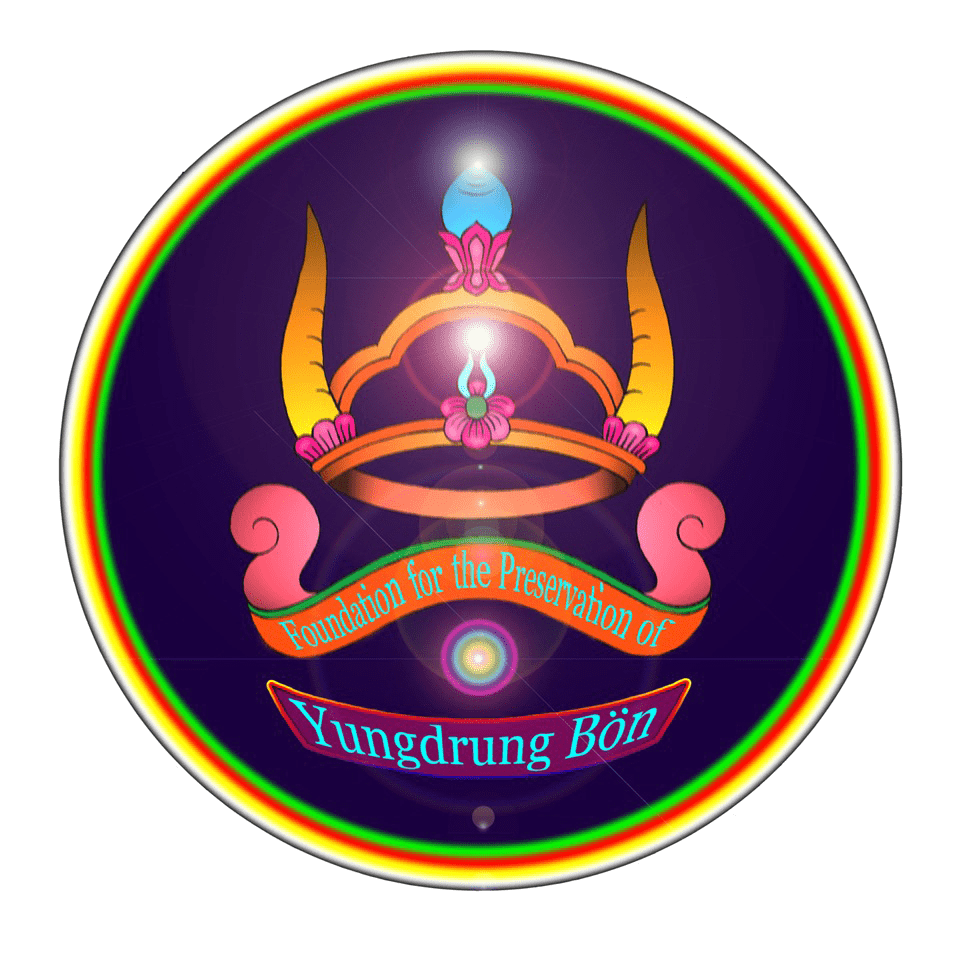For followers of various kinds of Bön[1] religions, Mount Kailash and the surrounding area is one of the most important, if not the most important, sacred regions on the whole of the Tibetan Plateau. Indeed, Mt. Kailash itself is referred to as Bönri[2] – the Bön Mountain. Particularly, Mt. Kailash played the most important role as the spiritual centre of Zhang Zhung[3] Empire where Bön, Yungdrung Bön[4] in particular, was the state religion.
[1] Tib. Bon / བོན།
[2] Tib. Bon-ri / བོན་རི།
[3] Tib. Zhang-zhung / ཞང་ཞུང་།
[4] Tib. G.yung-drung bon / གཡུང་དྲུང་བོན།
Four types of Bön
My use of the plural for Bön religions here is deliberate. Besides its other more general meanings, the word ‘bön’ refers to four major groups of spiritual traditions:
- The first one is Domai Bön[1] – Prehistoric Bön of Zhang Zhung and Tibet. This is the most ancient kind of Bön and was practised on the Tibetan Plateau prior to Tönpa Shenrab’s[2] arrival there. Domai Bön included many different ritual traditions addressed to various classes of gods and sprits and may be loosely labelled as ‘shamanic;’ this label is not at all satisfactory but we cannot go into particulars now due to the lack of time.
- The second is Yungdrung Bön – Religion of Swastika, sometimes also known as Bön Nyingma[3] or Old Bön, and is the teachings of the Central Asian Buddha Mura Tahen[4] who was born in Wolmo Lungring,[5] the central region of a larger Central Asian land called Tagzig,[6] somewhere to the North-West of Mt. Kailash. Mura Tahen is known in Tibet as Tönpa Shenrab Miwoche – which can be translated as ‘Supreme Teacher of Men’. Hence Yungdrung Bön is a ‘Buddhist’ doctrine in the large sense of the word.
- The third is Bön Sarma[7] or New Bön, a syncretic tradition which emerged in the 8th century AD as a result of the amalgamation of Yungdrung Bön and Shakyamuni’s Buddhism and created on the orders of Tibetan Emperor Trisong Deutsen.[8] Although on the ritual side, followers of New Bön use methods in which Yungdrung Bön and Indian Buddhism are mixed, as far as the doctrinal base is concerned, they rely firmly on the Yungdrung Bön cannon.[9]
- Mixed Bön. The above classification, however, does not take into account many traditions which arose as a result of these three types of Bön interacting and mixing in different proportions, often with the addition of elements from other religions such as Hinduism, Taoism, Native Siberian traditions and so on. So these kinds of eclectic traditions is the fourth kind of Bön, which I label ‘MIXED BÖN.’
[1] Tib. Gdod-ma’i bon / གདོད་མའི་བོན།
[2] Tib. Ston-pa Ghen-rab Mi-bo-che / སྟོན་པ་གཤེན་རབ་མི་བོ་ཆེ།
[3] Tib. Bon rnying-ma / བོན་རྙིང་མ།
[4] Tib. Dmu-ra ta-han / དམུ་ར་ཏ་ཧན།
[5] Tib. ‘Ol-mo Lung-ring / འོལ་མོ་ལུང་རིང་།
[6] Tib. Stag-zig / Stag-gzigs / Rtag-gzigs / Mtha’-gzigs / སྟག་ཟིག སྟག་གཟིགས། རྟག་གཟིགས། མཐའ་གཟིགས།
[7] Tib. Bon gsar-ma / བོན་གསར་མ།
[8] Tib. Khri-srong lde’u-btsan / ཁྲི་སྲོང་ལྡེའུ་བཙན།
[9] This three-fold division of Bön religions is the traditional classification found in Yungdrung Bön and Bön Sarma sources such as Legs bshad mdzod / ལེགས་བཞད་མཛོད། by Shar-rdza Bkra-shis rgyal-mtshan / སར་རྫ་བཀྲ་ཤིས་རྒྱལ་མཚན། (1859 – 1935), Dpal-tshul bstan-‘byung / དཔལ་ཚུལ་བཙན་འབྱུང་། by Dpal-ldan tshul-khrim (1902 -1973) and ‘Bel-gtam lung-snying / འབེལ་གཏམ་ལུང་སྙིང་། by Yongs-‘dzin Slob-dpon Bstan-‘dzin rnam-dag Rin-po-che / ཡོངས་འཛིན་སློབ་དཔོན་བསྟན་འཛིན་རྣམ་དག་རིན་པོ་ཆེ། (b. 1926). Mdo gzer-mig / མདོ་གཟེར་མིག also speaks of bod-kyi bon-po, followers of gdod-ma’i bon / གདོད་མའི་བོན། as opposed to gshen-po / གཤེན་པོ།, followers of g.yung-drung bon / གཡུང་དྲུང་བོན།.
Dhami and Dhangre of Humla
Mt. Kailash is important to all of these Bönpo traditions to a greater or lesser extent, but here I shall mostly focus on Yungdrung Bön since this tradition is still very much alive and has a large body of literature and oral traditions relating to Mt. Kailash. Furthermore, out of the four kinds of Bön mentioned above, this is the one with which I am most familiar. However, before we turn our attention to Yungdrung Bön, I would like to take a brief look at dhami and dhangre priests of Humla in Nepal, whose tradition can mostly be described as Prehistoric Bön with some later influences from Hinduism. Dhami are possessed by the gods residing on Kailash while dhangre act as ‘interpreters’ when dhami are uttering prophesies in trance. Both must make a pilgrimage to Kailash and lake Mapang Yutsö[1] (Manasarovar) in order to perform purification rituals, be initiated, and receive and recharge their powers. As you can see on illustrations below, dhami and dhangre’s ritual dress, consisting of white turban decorated with tufts of wool and white gown, is all but identical to the depiction of Bönpo priests in the old Bönpo manuscript and corresponds closely to that worn by practitioners of the First Vehicle of the Causal Ways[2] of Yungdrung Bön, the Chyashen Thegpa,[3] and in particular to that of the Aya Bönpo studied by Charles Ramble in ‘The Aya: Fragments of an unknown Tibetan Priesthood’
[1] Tib. Ma-pang g.yu-tsho / མ་པང་གཡུ་མཚོ།
[2] Tib. rgyu’i bon / རྒྱུའི་བོན།
[3] Tib. Phya-gshen theg-pa / ཕྱ་གཤེན་ཐེག་པ།

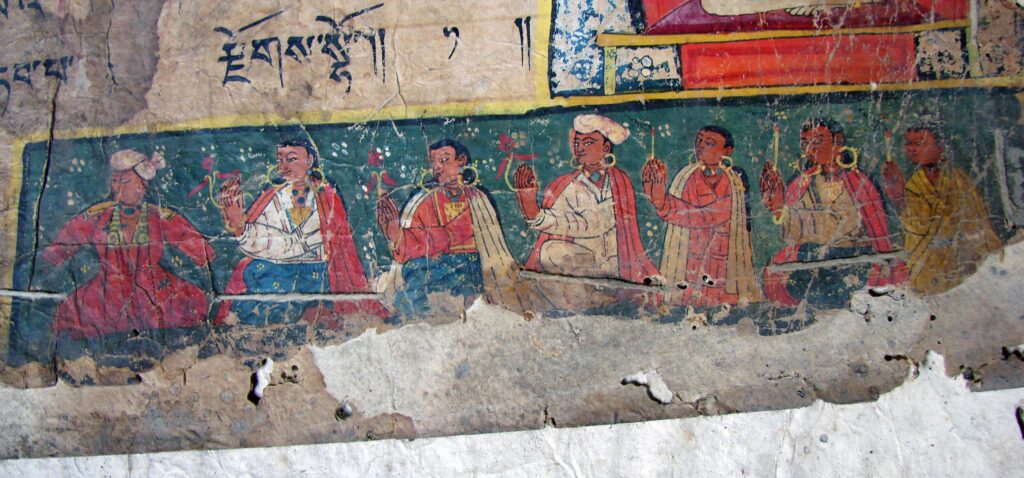
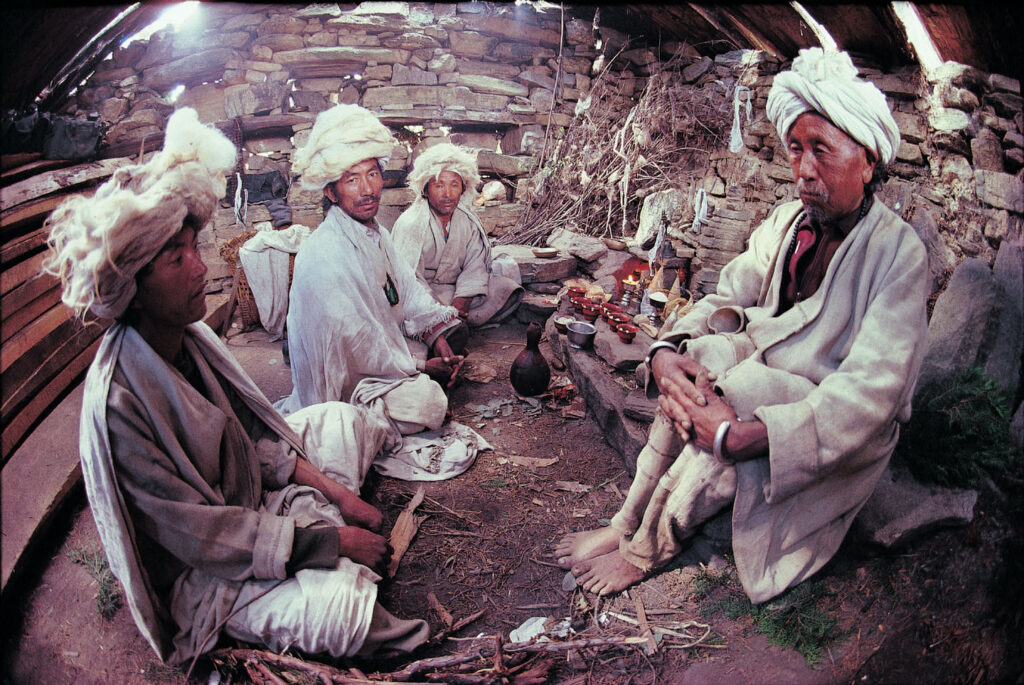
Left: Dhami from Humla, Nepal, praying to Mt. Kailash. Photo by Thomas L. Kelly. Courtesy of Loel Guinness.
Centre: A folio with the illustration showing people in ancient Zhang Zhung costume from a rare old text Khro-gsas dbal-phur sngags kyi mdo ༼ ཁྲོ་གསས་དབལ་ཕུར་སྔགས་ཀྱི་མདོ།༽ / Treatise on the Mantra of Wrathful Deity of Fierce Phurpa, kept in Yungdrung Changra Shar Gompa, Mustang. Photo by Nagru Geshe Gelek Jinpa.
Right: Dhami & dhangre wearing white turbans decorated with tufts of white wool just like those worn by the Aya Bönpos of Zhang Zhung. Photo by Thomas L. Kelly. Courtesy of Loel Guinness.
Description of Gangnyen Yabagshara, The Lord of Mt. Tise
Before Tönpa Shenrab Miwo came to Zhang Zhung mount Kailash was known under its ancient Zhang Zhung name Yabagshara after the eponymous worldly god Gangnyen Yabagshara[1] who resides in it. Here is his description from The Offering Prayer to Tise taken from Pönse Khyunggotsal’s terma discovered at Zangzang Hladrag:[2]
།ཀྱེ་འཛམ་བུ་གླིང་གི་དབུས་དཀྱིལ་ནས། ཏལ་ཟང་གངས་དཀར་རྩེ་རེ་མཐོ།།
Chye! From the centre ofའཇམ་ling rises the supremely high, resplendent white snow peak.
།ཤེལ་བྲག་གངས་ཀྱི་གཉན་རུམ་ན། །ཏེ་རྩེ་གངས་ཀྱི་མངའ་བདག་ནི།།
Inside this impregnable Crystal Snow Rock dwells the Lord of the Snow Mountain Tetse (Tise) –
འཛམ་གླིང་ཡར་གྱི་སྐྱེས་ཅིག་པོ། །སྐུ་ནི་གངས་རི་གཏམ་པ་འདྲ།
Great Being of the Highlands of the Southern Continent whose body is like a snow-clad mountain.
།ཤེལ་དཀར་བེར་ཆེན་སྐུ་ལ་གསོལ། །དབུ་ལ་ཤེལ་དཀར་ཐོད་རྡིང་ཅན། །དར་དཀར་མཛེས་པའི་ཐོད་ཀྱིས་བཅིང༌། །ཞབས་ལ་དངུལ་གྱི་ལྷམ་བུ་གསོལ།།
He wears a great cloak of white crystal over his body, his head is crowned with a white crystal ornament, his hair is bound with smooth white silk and his feet are shod in silver boots .
།གཡས་ན་ཤེལ་མདུང་དཀར་པོ་ལ། །ཤེལ་དར་དཀར་པོ་པུ་རུ་རུ།
In his right hand he holds a spear of shining crystal from which a white silk banner flutters – pu-ru-ru.
།གཡོན་ན་ཉི་ཟླ་གདུགས་ཆེན་འདེགས།
In his left hand he raises up the great parasol of the sun and moon.
།རིན་ཆེན་དོ་ཤལ་རྒྱན་དུ་མཛེས། །ཤེལ་གྱི་གཡུང་དྲུང་དབུ་ལ་འཁོར། །དར་དཀར་ལྕམ་རིས་ལྷབས་སེ་ལྷུབ།
He is adorned with a beautiful garland of precious jewels, a crystal yungdrung-swastika spins on top of his head and exquisite white silk brocades ripple on his body – hlab-se-hlub.
།ཆིབས་སུ་ཤེལ་གྱི་སེང་གེ་བཅིབས། །གཡུ་ཡི་སྒ་བསྟད་ཝངས་སེ་ཝང༌། །གཞའ་ཚོན་སྟན་བསྟད་ལྷབས་སེ་ལྷུབ། །གསེར་གྱི་གོང་སྨད་སི་ལི་ལི།
As he rides his steed, a crystal-white lion, the turquoise saddle creaks – wang-se-wang
the rainbow saddle cloth flutters – hlab-se-hlub,
the golden crupper jingles – si-li-li,
།ཉི་ཟླའི་གདུགས་ཆེན་ཁྲ་ལ་ལ།
and the great parasol of the sun and moon sways – thra-la-la!
[1] Tib. Gang-gnyan Ya-bag-sha-ra/ གང་གཉན་ཡ་བག་ཤ་ར།
[2] Tib. Dpon-gsas Khung-rgod-rtsal, Zang-zang lha-brag nas gter-ma nas gter las drangs-pa’i ti-se’i gsol-mchod / དཔོན་གསས་ཁྱུང་རྒོད་རྩལ་གྱིས་ཟང་ཟང་ལྷ་བྲག་ནས་གཏེར་ལས་དྲངས་པའི་ཏི་སེའི་གསོལ་མཆོད།
How Mount Yabagshara came to be called Tise
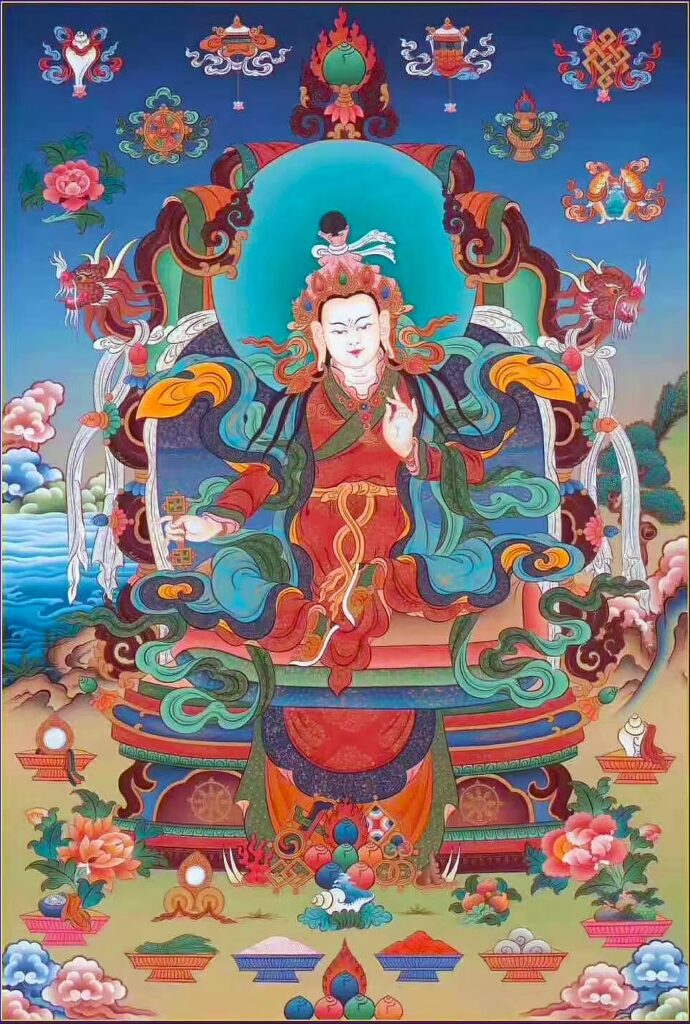
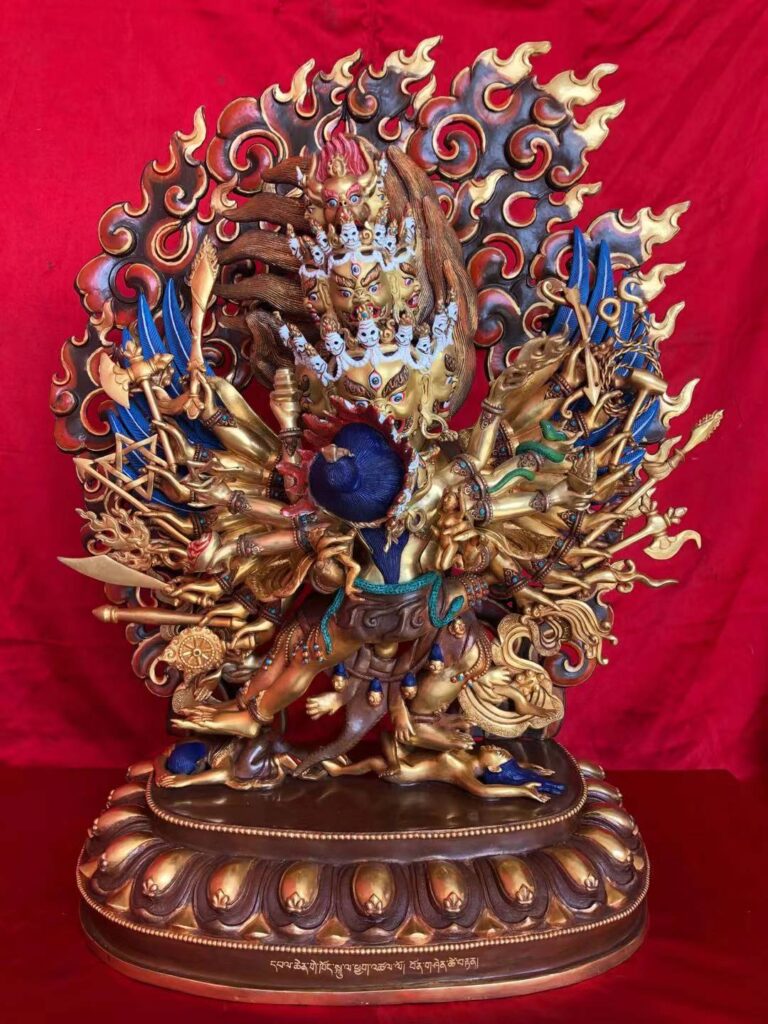
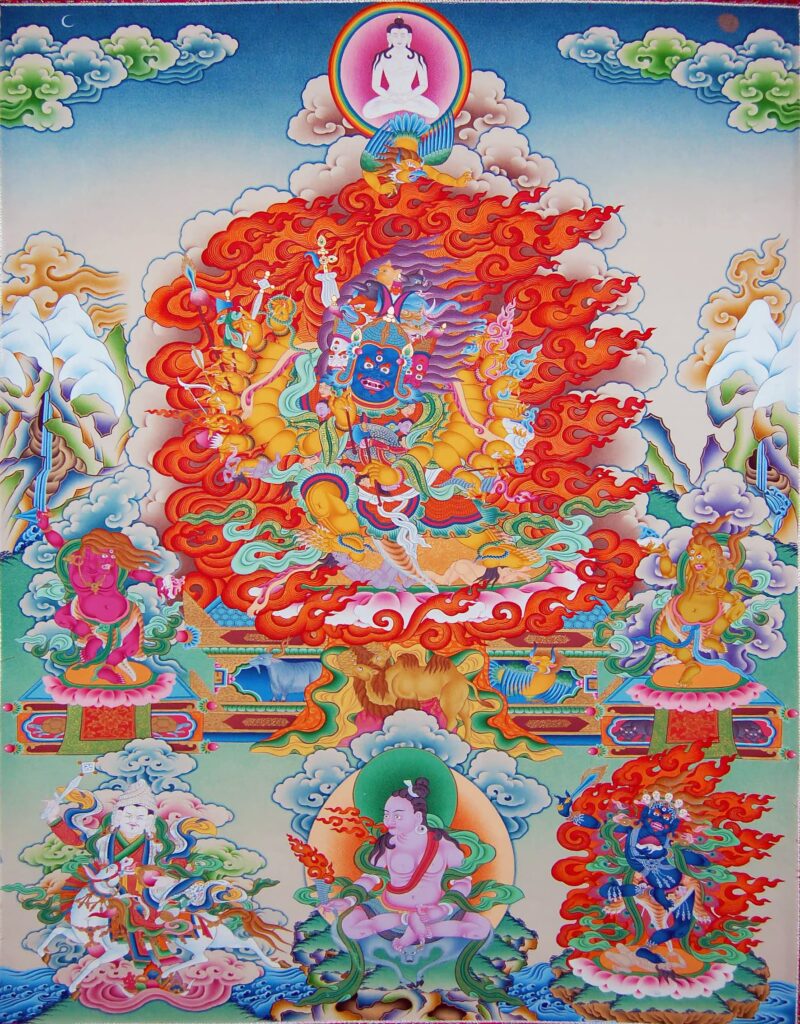
When Buddha Tönpa Shenrab Miwo came to Zhang Zhung from Central Asia in order to bless and protect the land from negativities arising from the Five Poisonous emotions[1] of sentient beings – anger, pride, attachment, envy and ignorance – which manifest externally as gods, demons, diseases and various natural calamities, he transformed into a huge white yak and entered Yabagshara Mountain where he manifested the mandala of Yonten Walchen Gekhö[2] – a wrathful Buddha-form, emanation of Buddha’s Quality. Thus the mountain and its surroundings were turned into a support for the 360 yidam-deities of this Bönpo Tantric cycle. That is why Tönpa Shenrab named Yabagshara ‘Tise’.[3] ‘Ti’ means ‘water’ in Zhang Zhung language and refers to the mountain being the source of the Four Great Rivers of Asia: Indus, Brahmaputra, Karnali and Sutlej, while ‘Se’ means ‘Guardian-deity’ and refers to the warrior-god form of Walchen Gekhö called Zhang Zhung Meri[4] who resides there. There are also other spellings – Te-rtse, Ti-rtse – which mean Water Peak.
[1] Tib. dug-lnga / དུག་ལྔ།
[2] Tib. Yon-gtan Dbal-chen ge-khod / ཡོན་གཏན་དབལ་ཆེན་དེ་ཁོད།
[3] Tib. Ti-se / ཏི་སེ།
[4] Tib. Zhang-zhung Me-ri / ཞང་ཞུང་མེ་རི།
Mt. Tise, Mt. Meru and Mt. Yungdrung Gutseg
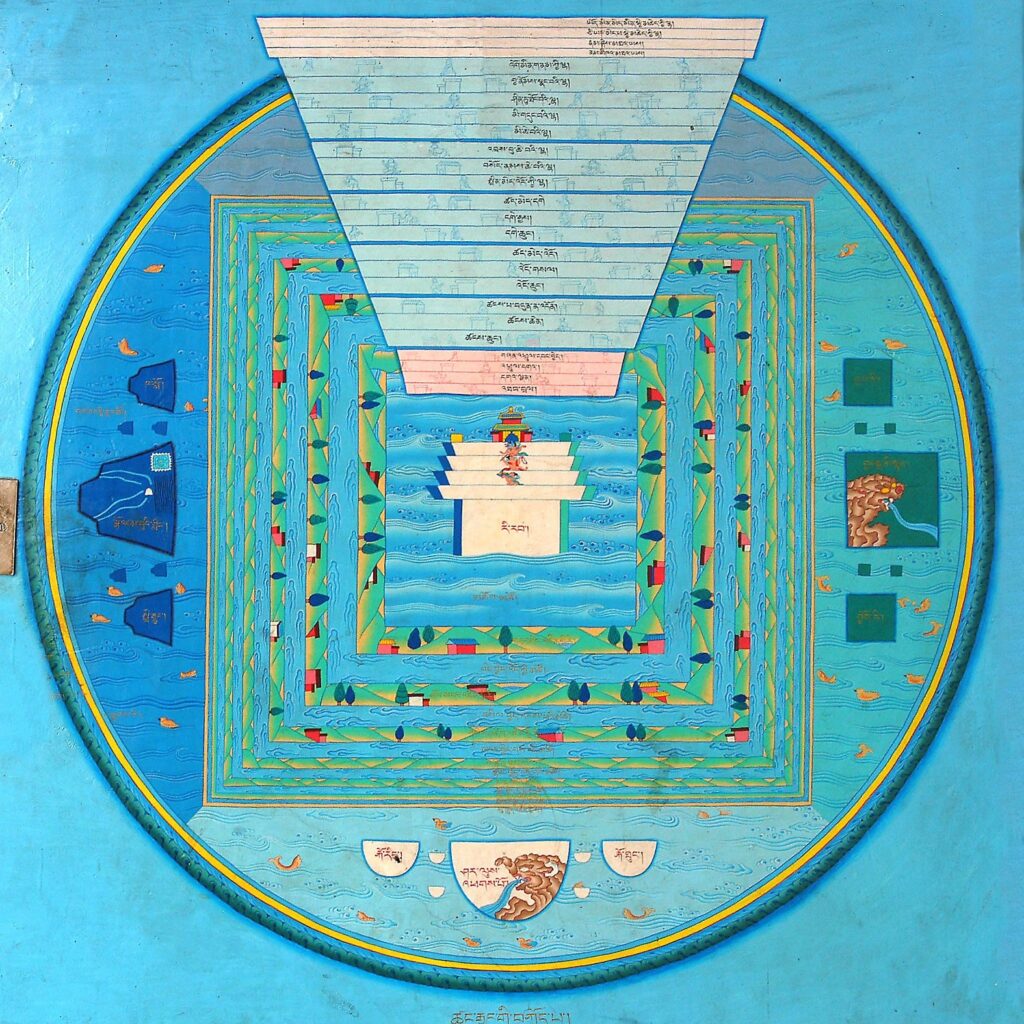
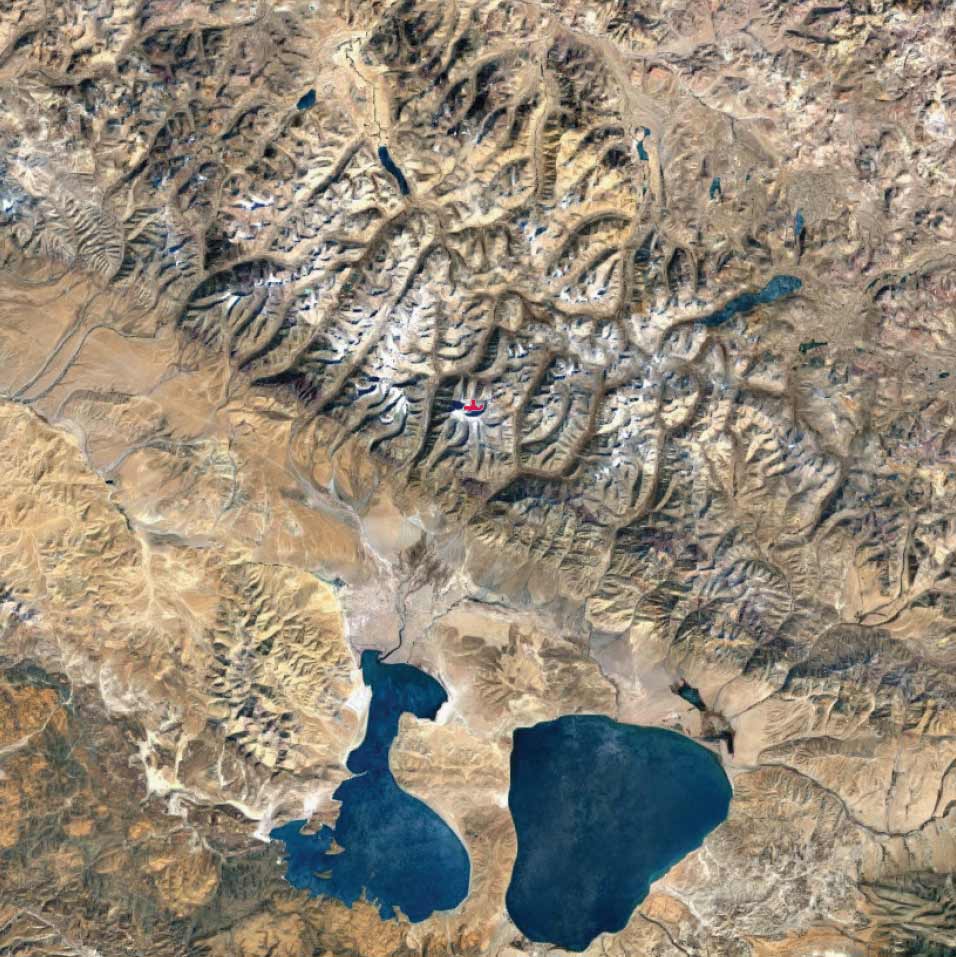
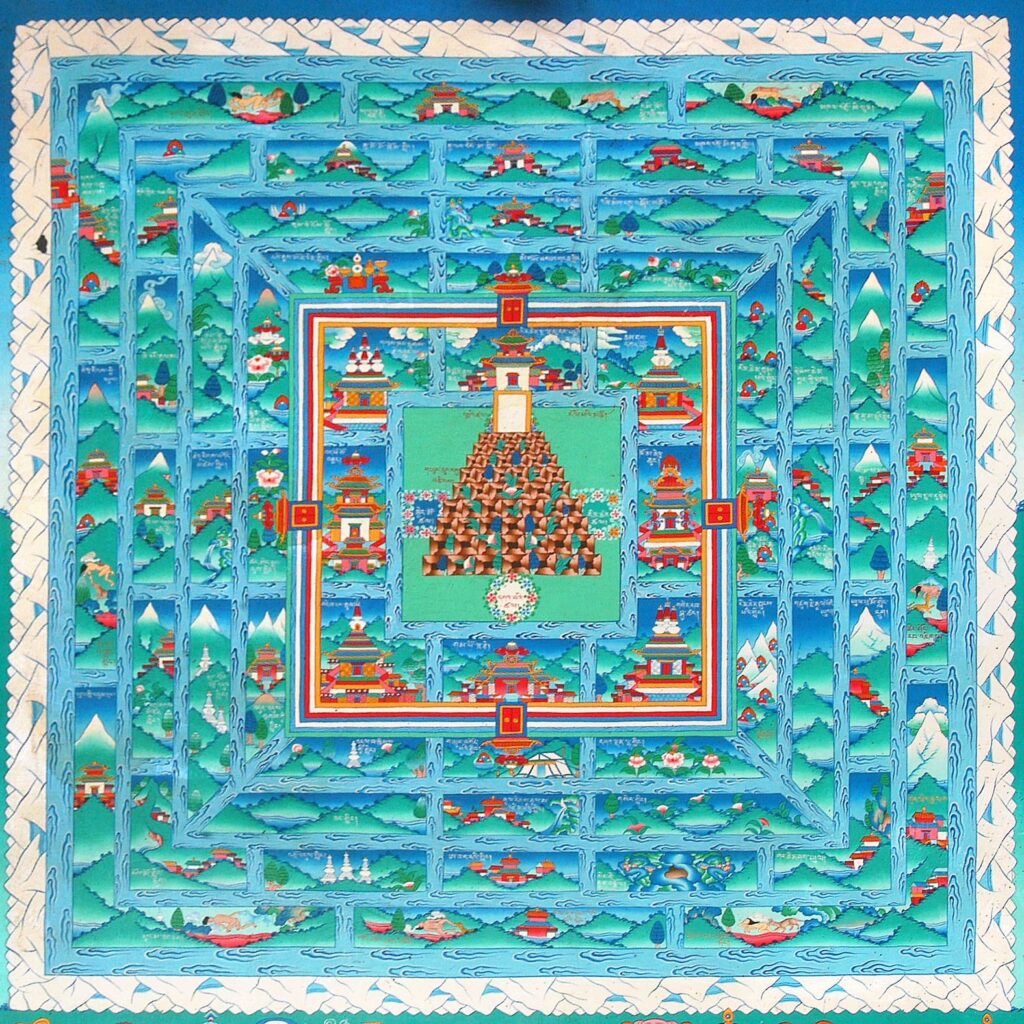
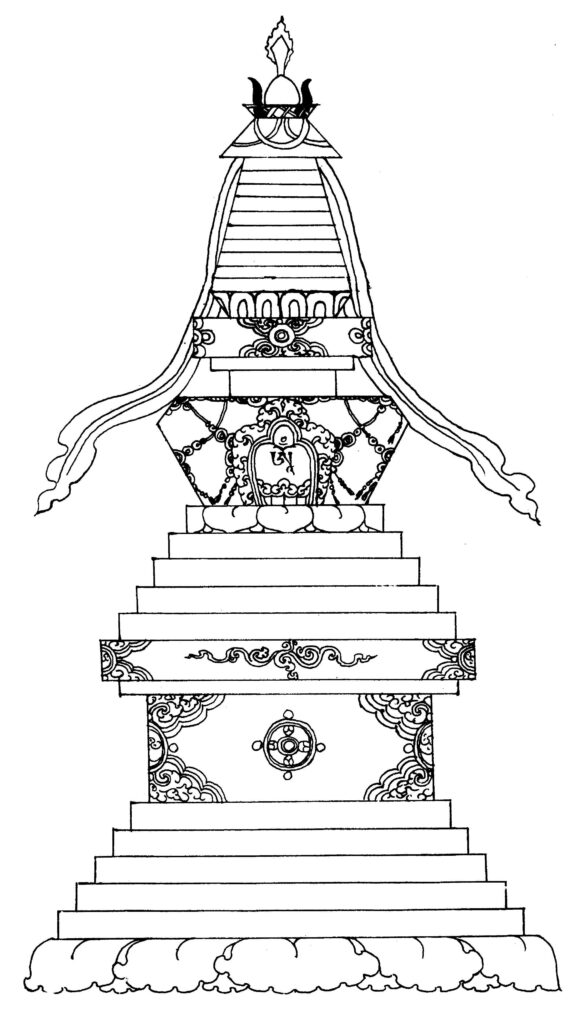
Left: Mt. Me-ru /Ri-rab Lhu-npo ༼ མེ་རུ།་རི་རབ་ལྷུན་པོ། ༽and the Four Continents. Mural in Triten Norbutse Monastery, Photo: C. Moulin.
Centre Left: Base satellite map, Mt. Ti-se ༼ ཏི་སེ། ༽, marked red with Lake Mu-le mtsho ༼ མུ་ལེ་མཚོ། ༽ (Lag-ngar-mtsho ༼ ལག་ངར་མཚོ། ༽ / Rakshas Tal – Below Left) & Lake Ma-dros dang-ra ༼ མ་དྲོས་དང་ར ༽ (Manasarovar, Ma-pang g.yu-mthso ༼ མ་པང་གཡུ་མཚོ། ༽ – Below Right). Based on Imagery ©2019 Landsat / Copernicus, Map data ©2019 10 km.
Centre Right: ‘Ol-mo lung-ring ༼ འོལ་མོ་མུང་རིང་།༽ with Mt. G.yung-drung dgu-brtegs ༼ གཡུང་དྲུང་དགུ་བརྩེགས། ༽ in the centre. Mural in Triten Norbutse Monastery, Photo: C. Moulin. Right: G.yung-drung bko-legs mchod-rten ༼ གཡུང་དྲུང་བཀོ་ལེགས་མཆོད་རྟེན། ༽– Well-proportioned Swastika Stupa. Drawing by Yongdzin Lopön Tenzin Namdak Rinpoche.
Some scholars identify Mt. Tise and the surrounding region as the World Mountain, Mt. Meru[1] (on the right) and /or Mt. Yungdrung Gutseg[2] – the Pyramid of the Nine Layers of Swastikas – which rises in the centre of Wolmo Lungring, the birth country of Tönpa Shenrab.
There is considerable confusion regarding this issue because the descriptions in the three versions of Tönpa Shenrab hagiography – Dodü, Zermig and Zibjyi[3] – and other texts are cryptic and often contradict each, other even within the same text, hence a profound knowledge of textual and oral sources is needed in order to clarify this. A person with such knowledge is Yongdzin Lopön Tenzin Namdak Rinpoche, the current Head Teacher of Yungdrung Bön. According to him, Mt. Tise is compared to Mt. Meru – the centre of the world – simply because Tise is in the centre of Dazmbuling,[4] the ‘Southern Continent’, roughly corresponding to Central and Southern Asia. Several Bönpo texts describe Mt. Tise as the uncreated and spontaneously perfect crystal snow stupa of nine layers of swastika, resting on the throne of the eight-petaled lotus, resembling externally the realm of Brahma, internally the three thousand places of Walchen Gekhö, and secretly serving as a gathering place for the mother sister khandro.[5] That is why it is venerated by the means of counter-clockwise circumambulation which is the Bönpo direction of purification and return to the original Buddha-Nature. This description is somewhat similar to that of Mt. Yungdrung Gutseg in Wolmo Lungring. However, with its central mountain Yungdrung Gutseg, Wolmo Lungring lies to the North-West of Tise in the pure dimension, hence their names and topology were superimposed onto the Tise region in some texts, as in the case with Mt. Meru. The logic behind this can be illustrated by the following example: There are over twenty cities, townships and communities in Canada and USA called Paris but they are not Paris of France. Settlers named these places after the original French Paris, or they were renamed because of some connection to the original city.
[1] Tib. Me-ru / Ri-rab lhun-po / མེ་རུ། རི་རབ་ལྷུན་པོ།
[2] Tib. G.yung-drung dgu-brtsegs / གཡུང་དྲུང་དགུ་བཙེགས།
[3] Tib. Mdo-‘dus, Gzer-mig, Gzi-brjid / མདོ་འདུས། གཟེར་མིག གཟི་བརྗིད།
[4] Tib. ‘Dzam-bu-gling / འཛམ་བུ་གླིང་།
[5] Tib. mkha’-gro / མཁའ་གྲོ།
Tise and Mapang as La-mountain and La-lake of Zhang Zhung and Tibet
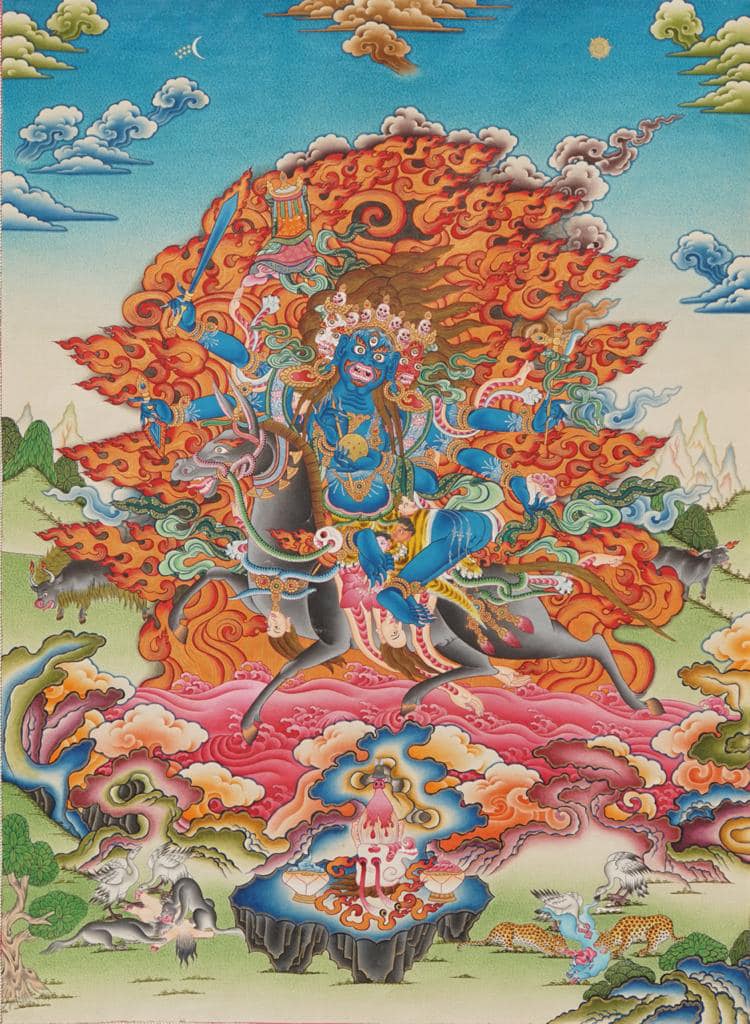

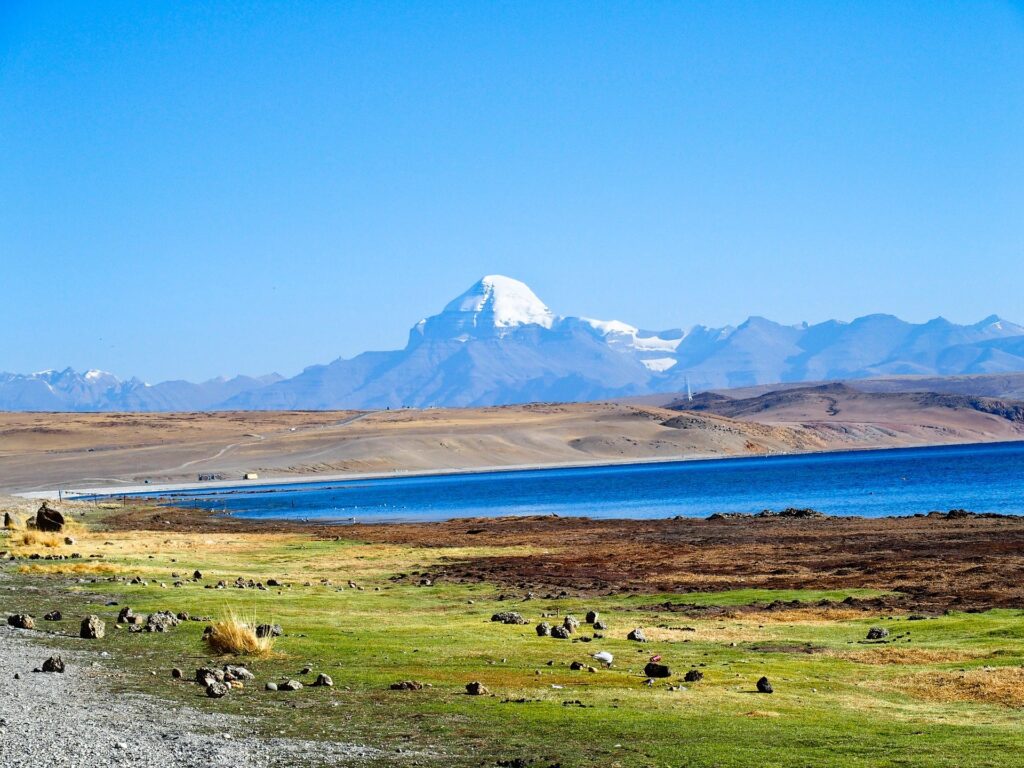
Left: Sipai Gyalmo, The Queen of Existence. Principal Guardian of Yungdrung Bön. Photo: C. Moulin.
Centre: Tise, Mapang (Madrö Dangra) & Muley Tso. Satellite photo. Credit: Ibid.
Right: Tise view from Mapang. Public domain.
Mt. Tise and Lake Mapang Yutso, called Madrö Dangra[1] by the Bönpos, are venerated as Lari and Latsö,[2] the La-mountain and La-lake of Zhang Zhung Emperors and all people of Zhang Zhung and later Tibet.
So what is la?[3] La is a very complex Bönpo concept for which there is no equivalent in other religions. Moreover, the term carries different meanings in Prehistoric Bön and Yungdrung Bön. In Prehistoric Bön it might be loosely associated with the idea of ‘soul’, while in Yungdrung Bön it is basically a function of bagchag,[4] karmic traces accumulated by an individual or a nation and the way they act on the internal and external elements, which on the individual level resultsin a short or long life, wealth or poverty, health or illness etc. and on the external plane as good or bad situations and environmental conditions experienced by the nation as a whole.
Tise and Mapang acted as lanay[5] receptacles of la for the whole nation of Zhang Zhung. Any changes in the appearance and conditions of the mountain and the lake were taken as either positive or negative portends followed by positive or negative events of national importance.[6] The lake serves as residence for a Naga-Queen, Lumo Wödenma,[7] and her retinue of 100,000 water-spirits. It also conceals the Wish-fulfilling Tree[8] and unimaginable treasures. To the left of the Madrö Dangra, as you see on this satellite photo, lies Lake Rakshas Tal, known to the Bönpos as Mule Tsö[9] which means ‘Silver Lake’. This is the abode of Drablai Gyalmo,[10] the Queen of Drabla and consort of Walchen Gekhö, who resides in Mt. Tise. She is an emanation of Sipi Gyalmo,[11] The Queen of Existence, who is the principal Guardian of Yungdrung Bön.
[1] Tib. Ma-dros dang-ra / མ་དྲོས་དང་གྲ།
[2] Tib. bla-ri, bla-mtsho བླ་རི། བླ་མཚོ།
[3] Tib. bla / བླ།
[4] Tib. bag-chags / བག་ཆགས།
[5] Tib. bla-gnas / བླ་གནས།
[6] For a detailed study of la and related concepts in Bön see: Ermakov, D. Bө and Bön, pp. 519-581.
[7] Tib. Klu-mo ‘Od-ldan-ma / ཀླུ་མོ་འོད་ལྡན་མ།
[8] Tib. Dpag-bsam ljon-shing / དག་བསམ་ལྗོན་ཤིང་།
[9] Tib. Mu-le mtsho / མུ་ལེ་མཚོ།
[10] Tib. Sgra-bla’i rgyal-mo / སྒྲ་བླའི་རྒྱལ་མོ།
[11] Tib. Srid-pa’i rgyal-mo / སྲིད་པའི་རྒྱལ་མོ།
Silver Palace of Garuda Valley at Khardong Nashul
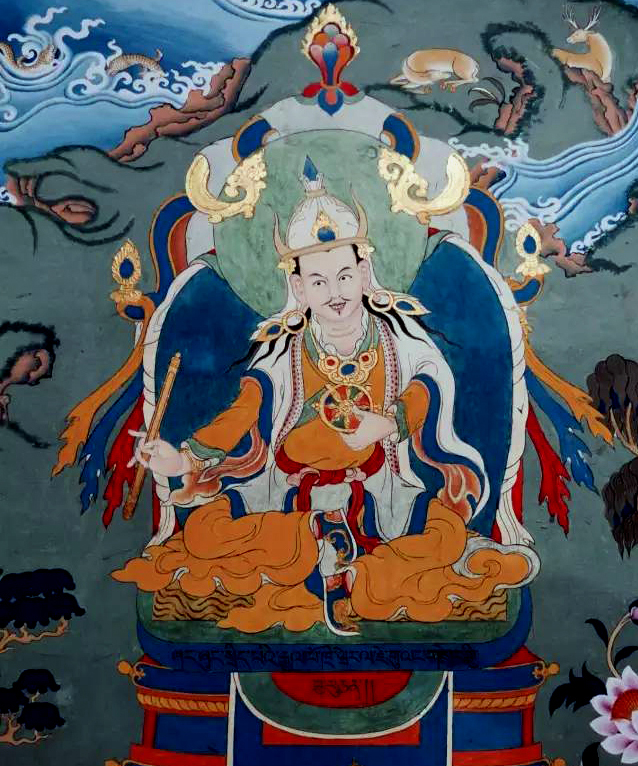
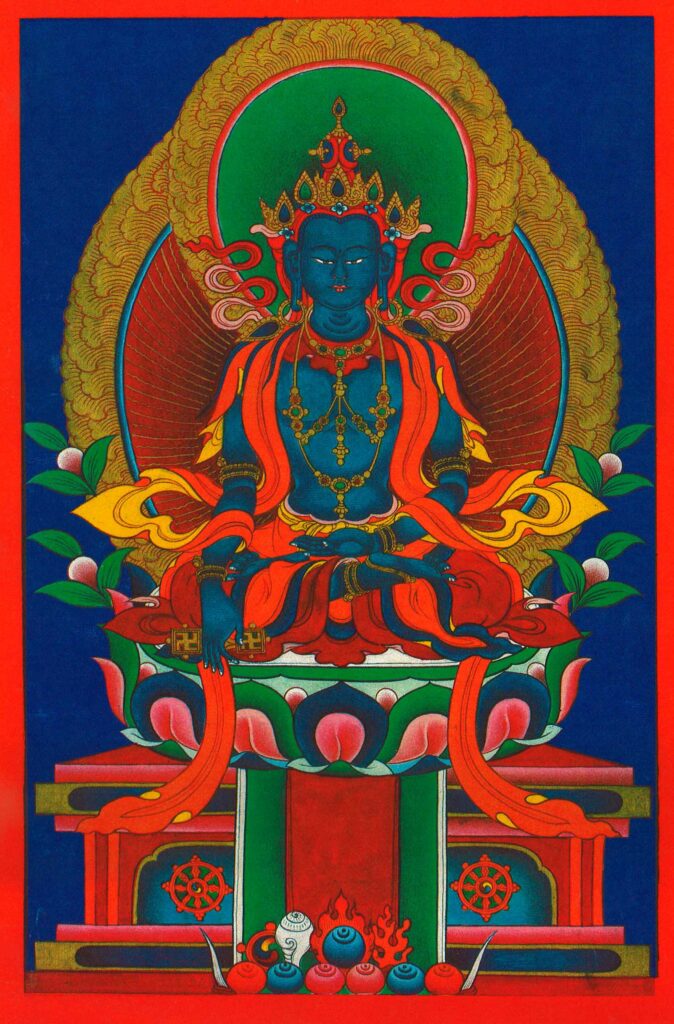
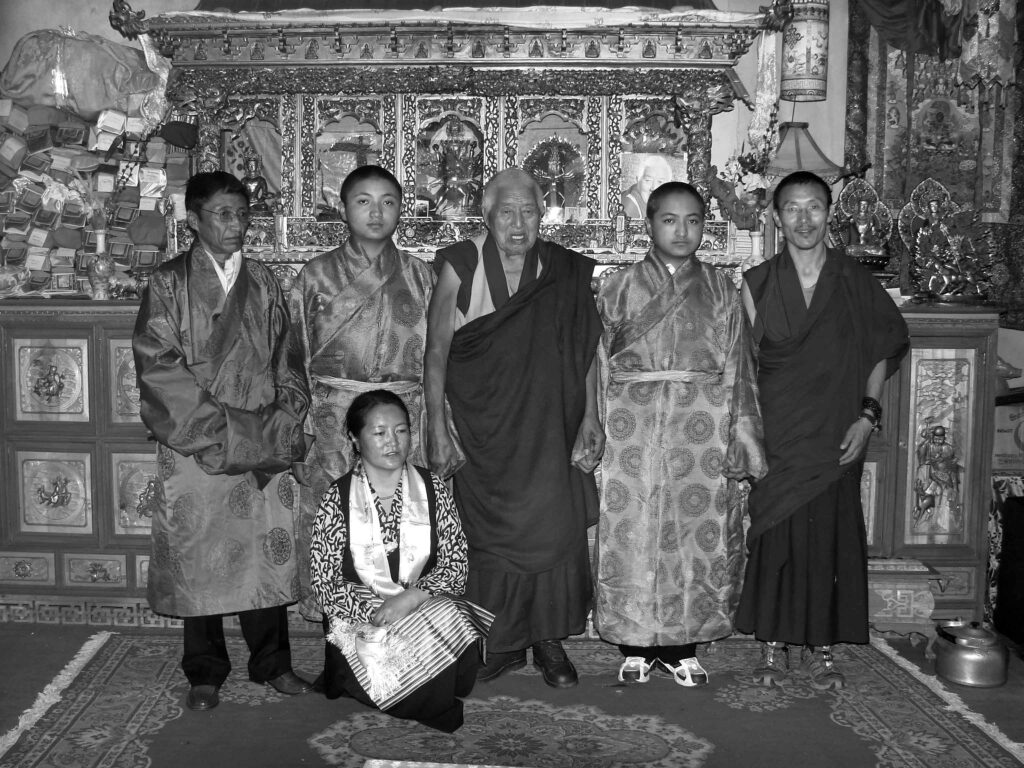
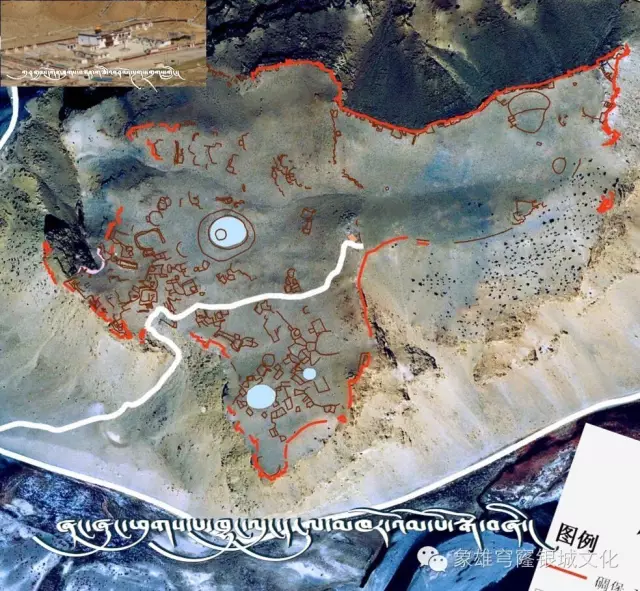
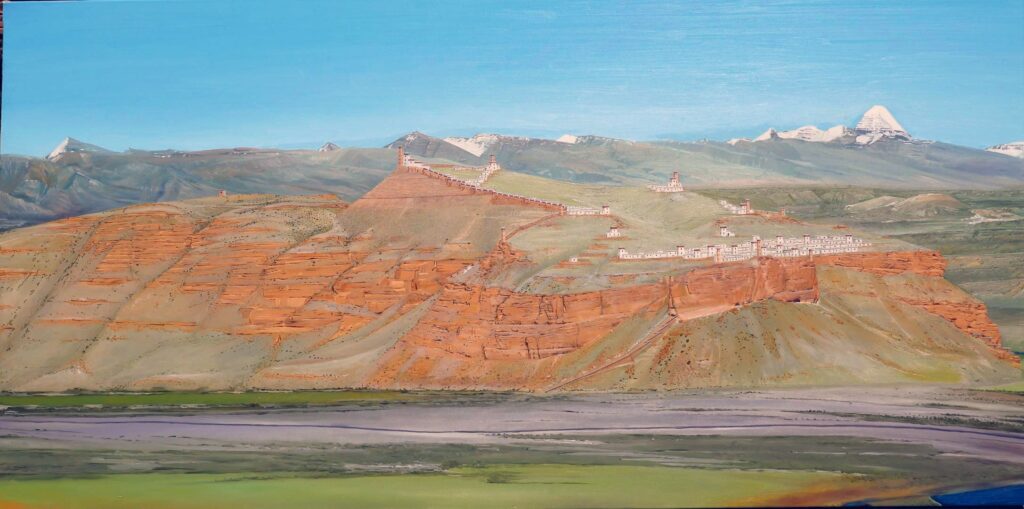
Top Left: Zhang Zhung Emperor Thrije Lawer Sergyi Gyaruchen.
Top Centre: Tönpa Shenrab Miwo. Courtesy of Yongdzin Rinpoche.
Top Right: Shentsang family members with Yongdzin Lopön Tenzin Namdak Rinpoche and Khenpo Tenpa Yungdrung, Tibet, 2007. Courtesy of Khenpo Tenpa Yungdrung.
Bottom Left: Satellite image of Khynglung Ngulkhar at Khardong Nashull. Courtesy of Lama Tsultrim Puntsog of Gurgyam Monastery.
Bottom Right: Khyunglung Ngulkhar – reconstruction. Painting by Tenpai Nyima. Courtesy: Ibid.
Mt. Tise was the spiritual axis of the Zhang Zhung Empire and cradle of Yungdrung Bön on the Tibetan Plateau, consecrated by Buddha Tönpa Shenrab himself and continuously blessed by the presence and practice of numerous Bönpo sages and practitioners. As such, the area is full of holy sites of Yungdrung Bön religion. Since we cannot go into details here due to the short format of this presentation, I will just highlight the main historical events in the spread, decline and revival of Yungdrung Bön in this region.
The most important event was, of course, the arrival of Tönpa Shenrab from Wölmo Lungring at during the reign of Thrije Lawer Sergyi Gyaruchen,[1] the first of the Eighteen Zhang Zhung Emperors, Bearers of the Horned Crown of Garuda, whose residence was at Gajang Yulo Dzong Castle[2] in front of Mt. Tise at the foot of Mt. Pori Ngeden.[3] According to some sources, it was Tönpa Shenrab himself who built the famous Khyunglung Ngulkhar,[4] the Silver Palace of Garuda Valley, located one day’s walk from Tise, during the period of his Second Deed, The Deed of Spreading the Teachings.[5] It is in this palace that one of his sons, Kontsa Wangden,[6] was born, from whom the Shen blood line has passed on over the millennia and is still alive today in Tibet.
There are different opinions regarding the exact location of this palace and I am keeping an open mind. However, since I have recently bee co-translated an article on this subject by Lama Tsultrim Phuntsog[7] of Gurjam[8] monastery, I present his version here. According to Lama Tsultrim Phuntsog, Khuyunglung Ngulkhar was located approximately 2km East of Gurgyam, at Khardong Nashul.[9] The satellite photo above shows the remains of the defence walls marked red, the ruins of various buildings and two wells marked by white circles. Next to it is a reconstruction painting by Tenpai Nyima.[10]
[1] Tib. Khri-rje La-wer Gser-gyi-bya-ru-can / ཁྲི་རྗེ་ལ་ཝེར་གསེར་གྱི་བྱ་རུ་ཅན།
[2] Tib. Ga-ljang g.yu-lo rDzong-mkhar / ག་ལྗང་གཡུ་ལོ་རྫོང་མཁར།
[3] Tib. Spo-ri ngad-ldan / སྤོ་རི་ངད་ལྡན།
[4] Tib. Khyung-lung ngul-mkhar / ཁྱུང་ལུང་ངུལ་མཁར།
[5] Tib. rnam-par spel-ba’i mdzad-pa / རྣམ་པར་སྤེལ་བའི་མཛད་པ།
[6] Tib. Kong-tsa g.yung-drung Dbang-ldan / ཀོང་ཙ་གཡུང་སྲུང་དབང་ལྡན།
[7] Tib. Bla-ma Tshul-khrims phun-tshogs / བླ་མ་ཚུལ་ཁྲིམས་པུན་ཚོགས།
[8] Tib. Gur-gyam dgon-pa / གུར་གྱམ་དགོན་པ།
[9] Tib. Mkhar-gdong gna’shul / མཁར་གདོང་གནའ་ཤུལ།
[10] Tib. Bstan-pa’i nyi-ma / བསྟན་པའི་ཉི་མ།
Bönpo Tantra and Dzogchen in the Mt. Tise region
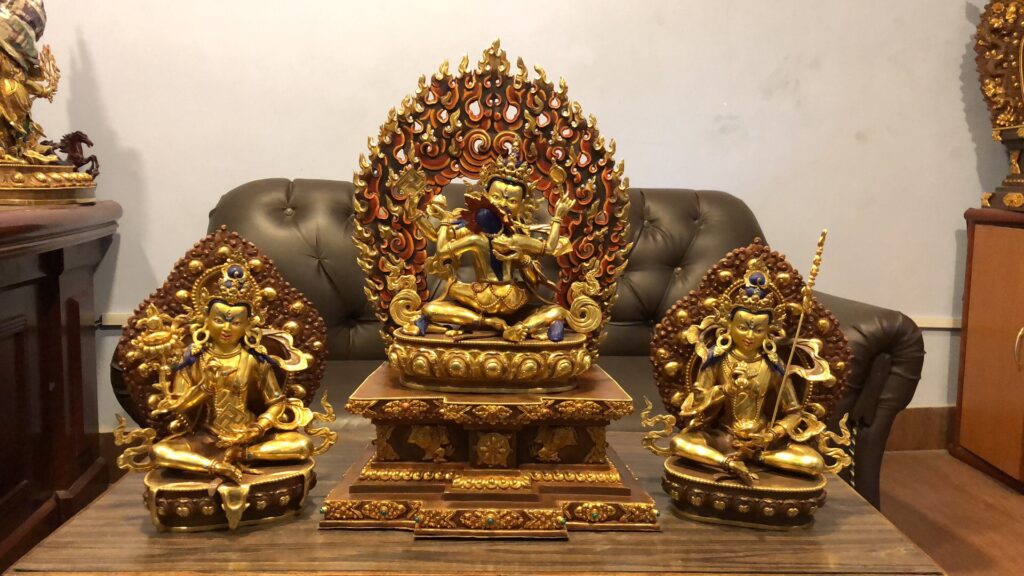
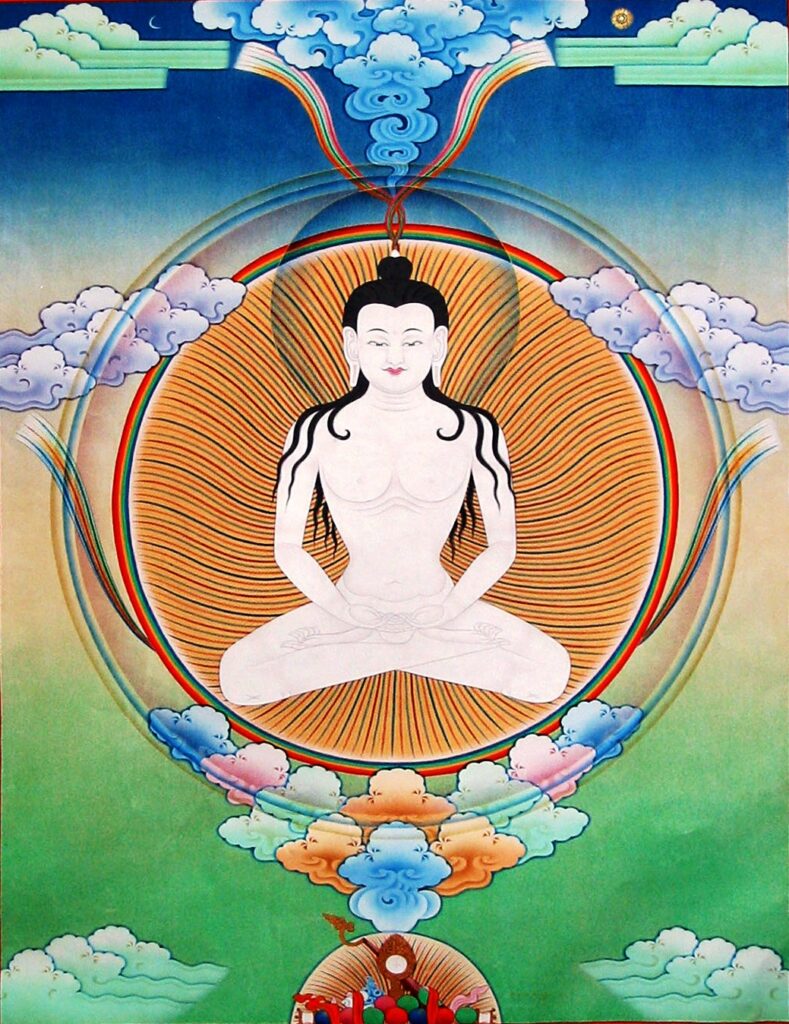
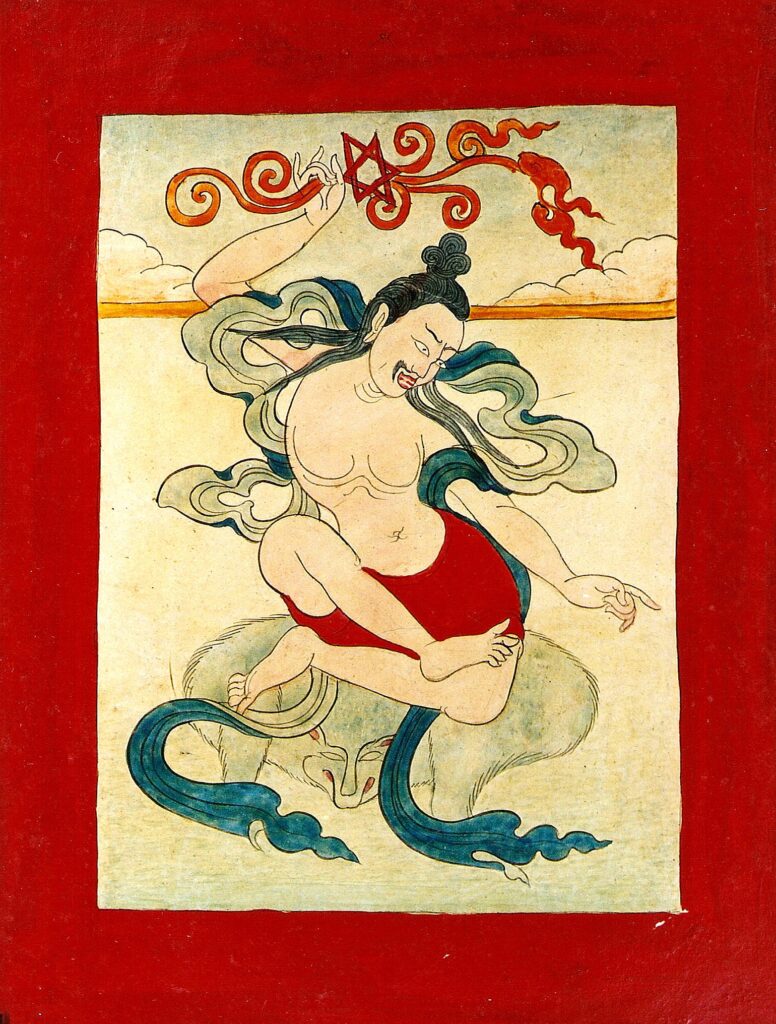
Top Left: Father and Mother: Gyerpung Drenpa Namkha (b. 914 BC, traditional) and Consort Wöden Barma; Sons: Tsewang Rigdzin and Pema Thongdrol (b. 888 BC, traditional). Photo courtesy of Drubdra Khenpo Tsultrim Tenzin.
Top Centre Left: Zhang Zhung Nyengyu lineage master Tapihritsa (7-8 c. AD). Photo: C. Moulin.
Top Centre Right: Zhang Zhung Nyengyu lineage master Gurub Nangzher Lödpo (7-8 c. AD). Credited with subduing Trisong Deutsen and thereby halting persecution of Yungdrung Bön in Zhang Zhung and Tibet. Tsakali initiation card. Courtesy of Yongdzin Lopön Tenzin Namdak Rinpoche.
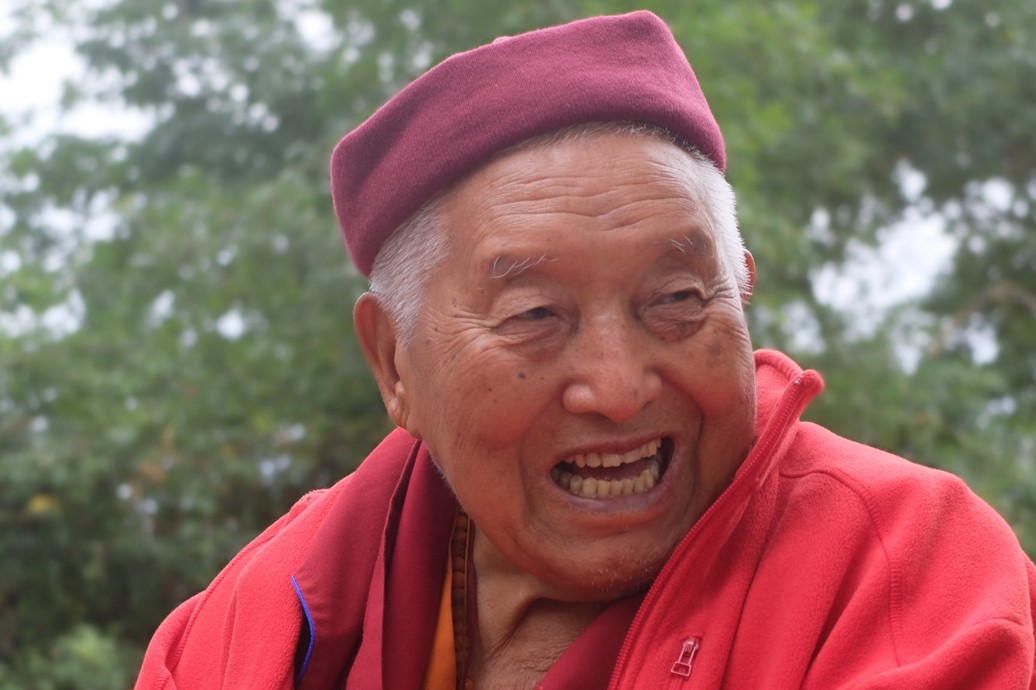
Yongdzin Lopön Tenzin Namdak Rinpoche, current Lineage-holder of Zhang Zhung Nyengyu and Head Teacher of Yungdrung Bön tradition. Photo: Carol Ermakova.
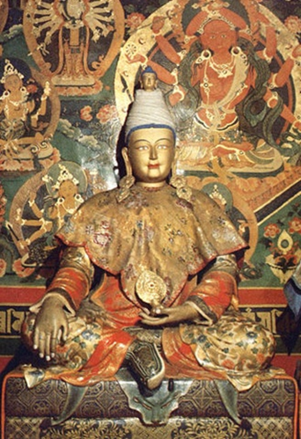
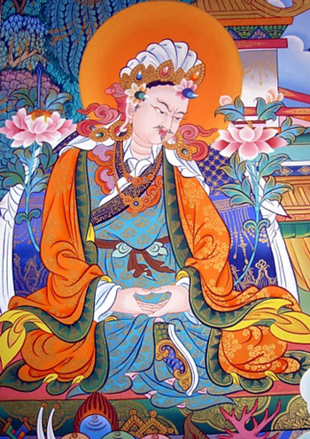
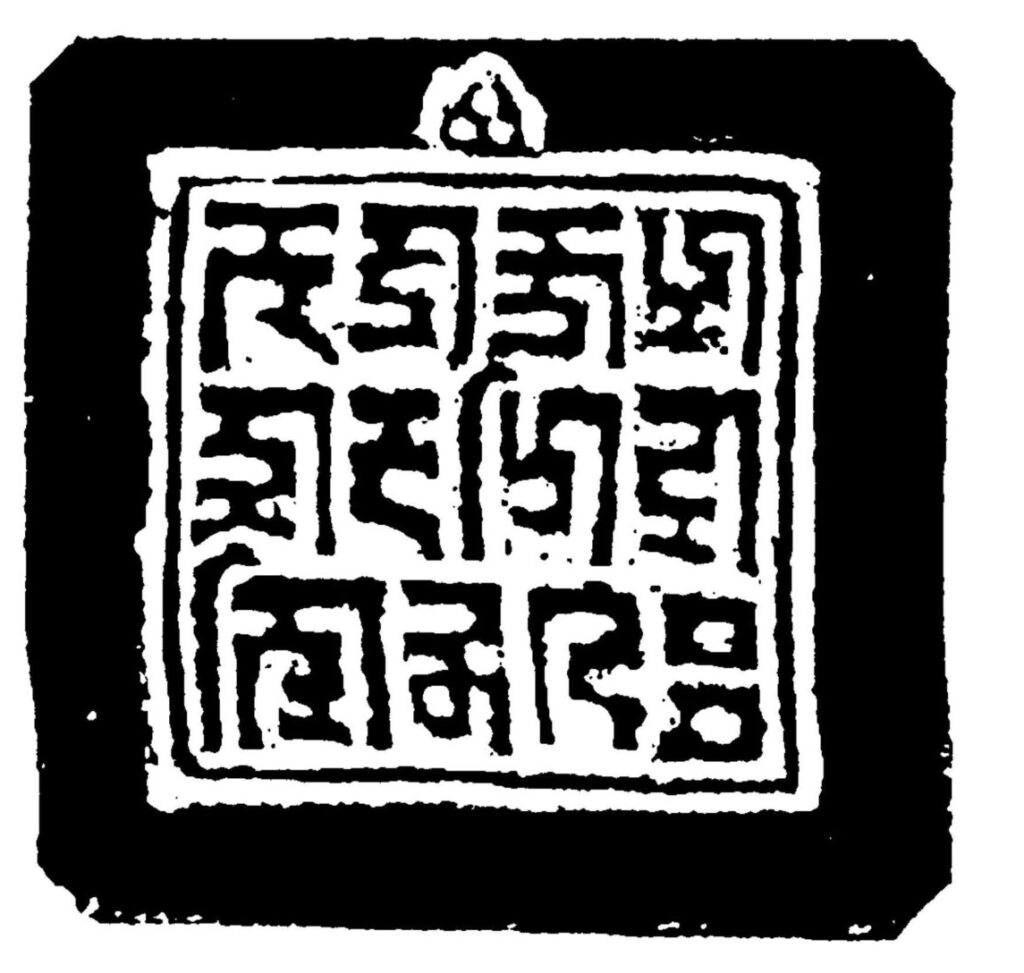
Left: Srongtsen Gampo (b. 569 AD). Public Domain.
Centre: Trisong Deutsen (b. 718 AD or 742 AD). Public domain.
Right: Iron Seal of Ligmincha Emperors in Zhang Zhung Marchen script. The inscription reads ‘King of Existence, Master of All’. Currently held in the New Menri Monastery in Dolanji, India. Courtesy of Yongdzin Lopön Tenzin Namdak Rinpoche.
Other very important Bönpo masters also hail from Khyunglung Ngulkhar. In particular, Gyerpung Drenpa Namkha[1] and then his twin sonsTsewang Rigdzin and Pema Thongdro,l[2] were all born here. They practised, achieved realisation and spread Bönpo Tantra[3] and Dzogchen[4] far and wide beyond Zhang Zhung and Tibet.
Zhang Zhung Nyengyu,[5] The Oral Transmission of Dzogchen from Zhang Zhung, is the most important Dzogchen lineage in Yungdrung Bön because it has never been interrupted since it was first taught by Tönpa Shenrab up until today. The current lineage-holder is Yongdzin Lopön Tenzin Namdak Rinpoche. All the early lineage-holders of this traditions lived around Mt. Tise, they also practised Zhang Zhung Meri as their Tantric Yidam and attained the Rainbow Bodies of Great Transfer[6] in this region. Tapihritsa and Gurub Nangzher Lödpo[7] were crucial for preserving Yungdrung Bön teachings in Zhang Zhung and Tibet in the 7th-8th centuries A.D. when Zhang Zhung was being taken over by the expanding Tibetan Empire. The Tibetan Emperor Srongtsen Gampo[8] began the takeover of Zhang Zhung and his great great great grandson Trisong Deutsen completed it by killing the last Zhang Zhung Ligmincha[9] Emperor. At the same time, Trisong Deutsen’s Buddhist-dominated government unleashed a wave of repressions on Yungdrung Bön. Ligmincha’s widowed Queen beseeched Nangzher Lödpo to act, to put a stop to the destructive actions of the Tibetans. He complied and, using an auxiliary method of Zhang Zhung Meri Tantra, he hurled a magic dzö[10] missile into Tibet, where it caused Trisong Deutsen to fall mortally ill. That is how he depicted on the tsakali initiation card here. Guessing where the missile came from, the Tibetan King gues sent ambassadors to Zhang Zhung to negotiate a deal with Nangzher Lödpo, who was then residing on an island in Lake Darog.[11] The deal was as follows: Nangzher Lödpo reverses the curse and Trisong Deutsen stops persecuting Yungdrung Bön. Both held their end of the bargain. Tapihritsa then gave Nangzher Lödpo permission to break with previous tradition and teach Zhang Zhung Nyengyu to more than one disciple, because the times demanded it. And so the teachings spread.
[1] Tib. Gyer-spungs Dran-pa nam-mkha‘ / གྱེར་སྤུངས་དྲན་པ་ནམ་མཁའ།
[2] Tib. Tshe-dbang rig-‘dzin, Padma mthong-grol / ཚེ་དབང་‘རིག་འཛིན། པདྨ་མཐོང་གྲོལ།
[3] Tib. gsang-sngags, rgyud-sde / གསང་སྔགས། རྒྱུད་སྡེ།
[4] Tib. rdzogs -chen / རྫོགས་ཆེན།
[5] Tib. Zhang-zhung snyan-rgyud / ཞང་ཞུང་སྙན་རྒྱུད།
[6] Tib. ‘ja’-lus ‘pho-ba chen-po / འཇའ་ལུས་འཕོ་བ་ཆེན་པོ།
[7] Tib. Ta-pi-hri-tsa, Gu-rub Snang-bzher lod-po / ཏ་པི་ཧྲི་ཙ། གུ་རུབ་སྣང་བཞེར་ལོད་པོ།
[8] Tib. Srong-btsan sgam po / སྲོང་བཙན་སྒམ་པོ།
[9] Tib. Lig-mi-rgya / ལིག་མི་རྒྱ།
[10] Tib. dzwo / ཛྭོ།
[11] Tib. Da-rog / ད་རོག
Persecution and restoration of Bön and Dzogchen in Ngari, Western Tibet
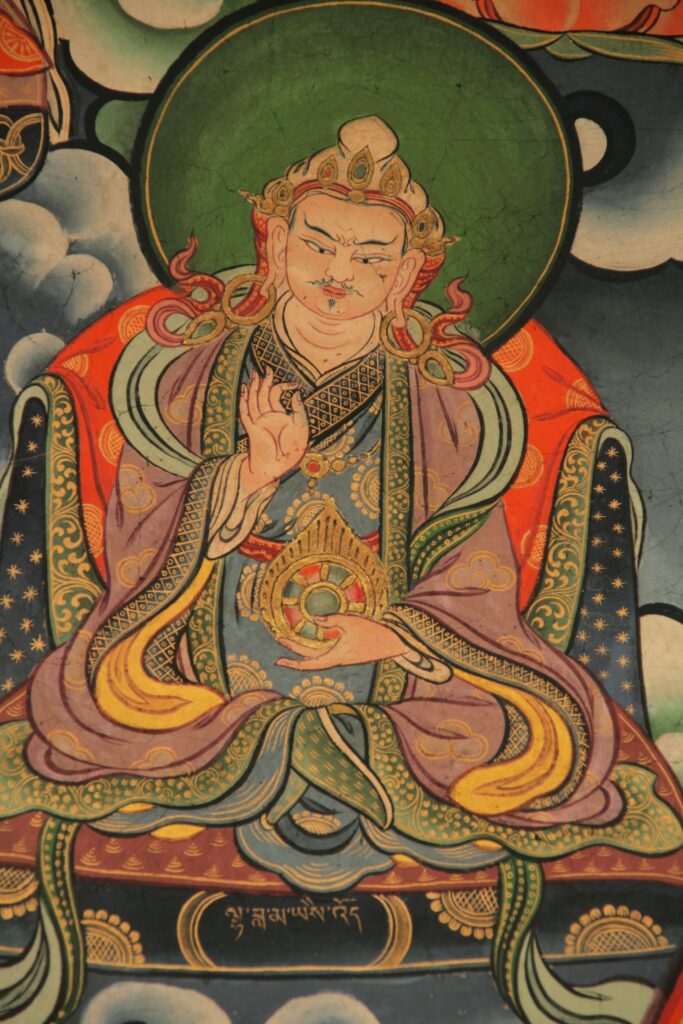
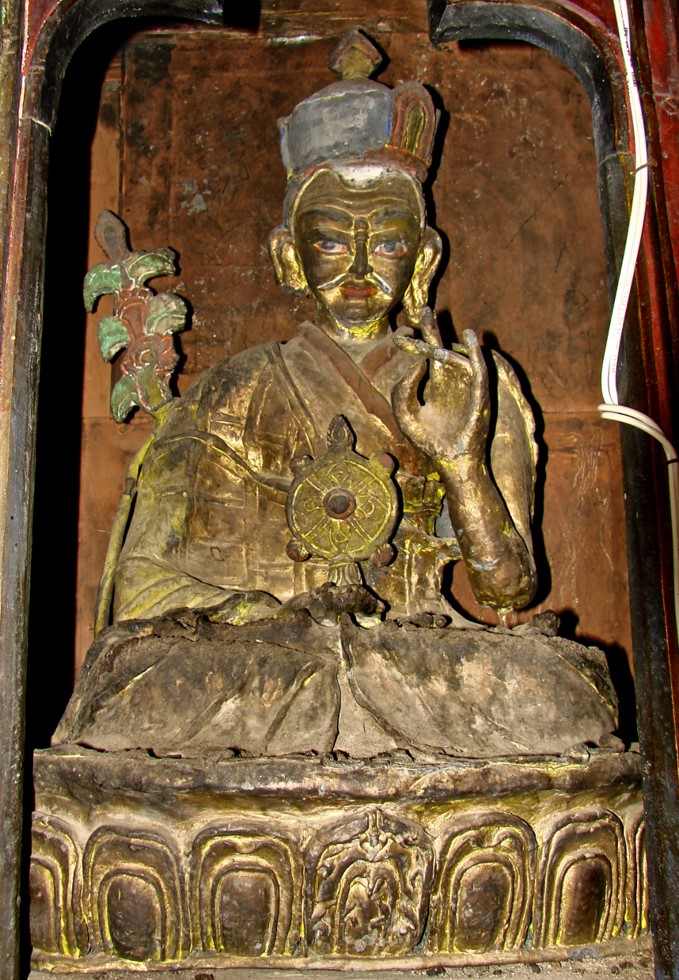
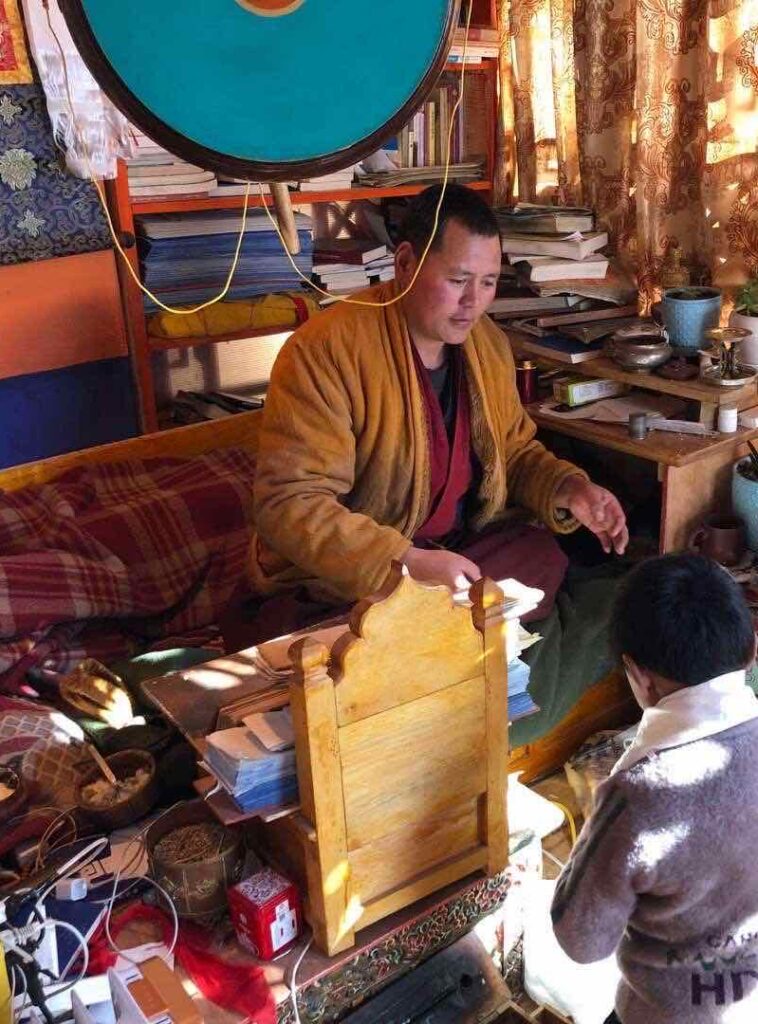
Left: Hla Lama Yeshewö (947-1024).
Centre: Karru Drubwang Tenzin Rinchen (1801 -1861). The author of The Guide to the Snow Mount Tise (Gangs ti-se’i dkar-chag ༼གངས་ཏི་སེའི་དཀར་ཆག༽). Statue in G.yung-drung kun-grags-gling, Jomsom ༼གཡུང་དྲུང་ཀུན་གྲགས་གླིང་།༽, Nepal. Photo courtesy of Nagru Khenpo Gelek Jinpa.
Right: Lama Tsultrim Phuntsog, Abbot of Gurgyam Gonpa.
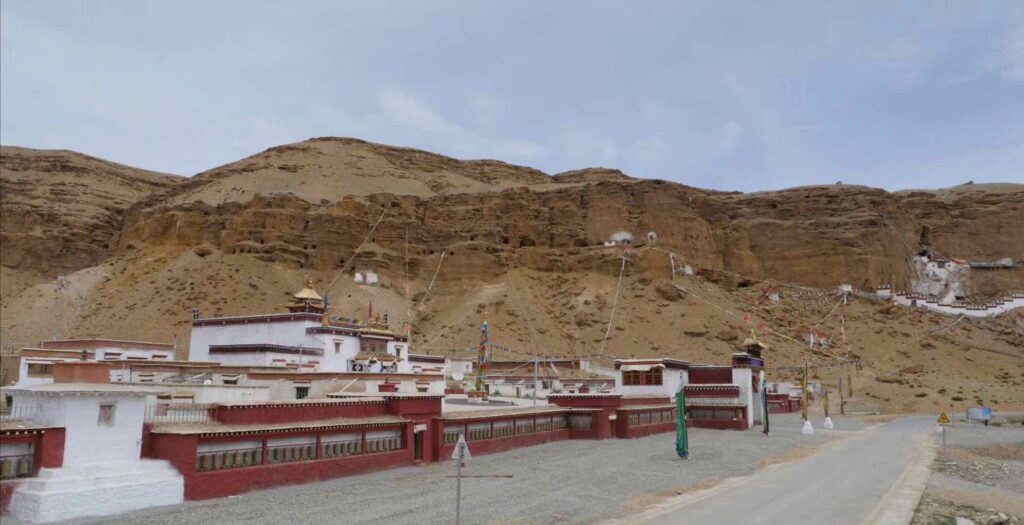
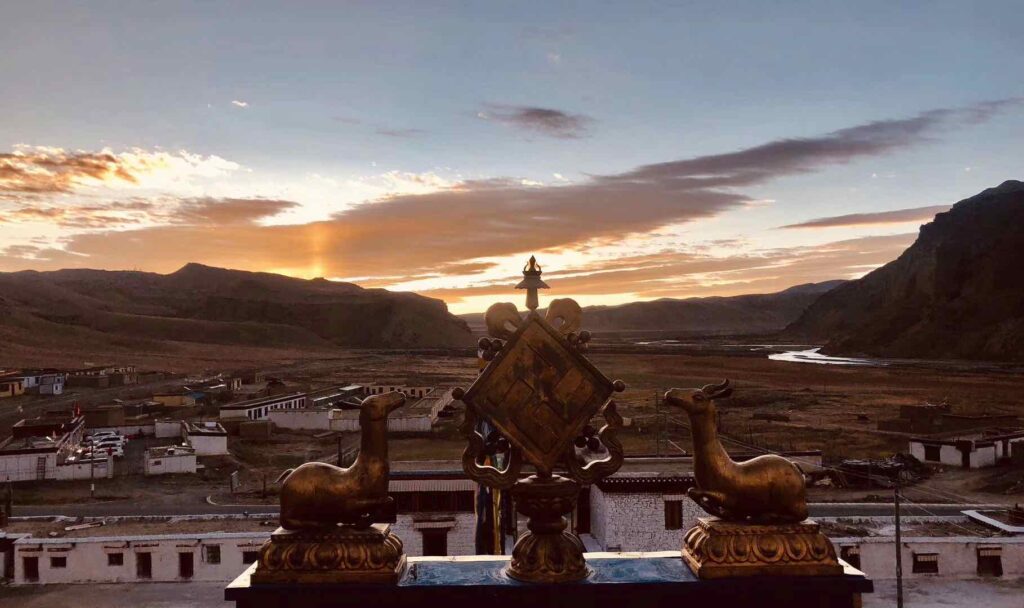
Left: Gurgyam Gompa with the Practice Cave of Precious Blazing Swastika (G.yung-drung rin- chen ‘bar-wa’i sgrub-phug ༼གཡུང་དྲུང་རིན་ཆེན་འབ་བའི་སྒྲུབ་ཕུག༽) in the cliff top right.
Right: View from the roof of the main temple at Gurgyam Gompa. Photos courtesy of Lama Tsultrim Phuntsog.
Although Yungdrung Bön was badly damaged in Central Tibet as result of the persecution, 360 types of Bön were preserved in full in Zhang Zhung thanks to Nagzher Lödpo. In the centuries that followed, although deprived of the status of state religion, Yungdrung Bön was practised continuously in the Tise region, which became part of Ngari,[1] Western Tibet, from around 930 AD onwards. During the reign of King Hla Lama Yeshewö (947-1024),[2] who initiated what became known as the Second Diffusion of Buddhism,[3] Yungdrung Bön was once again persecuted, this time in its heartland. Dzogchen was particularly singled out as a heretical teaching. Both a biography of King Hla Lama Yeshewö and some of his decrees which recently came to light clearly show that he banned the teachings of Tantra and Dzogchen and ordered anyone practising them to be punished:
“…The followers of the Ati, the Bon, divination, the “astrological science” from Zhang zhung such as the perverted astrology of sKar stad stand in contradiction to the agama and opposed to the logical reasoning. These erroneous matters are not to be taught and not to be exposed to others. The books that deal with them are not to be kept. Those, who teach them and keep the books, shall be punished in accordance with the Chos. For the minor offences, the culprit shall do more than hundred prostrations. If the person still keeps the books, the books shall be burnt and the person shall be told three times not to keep the books again. If there is no improvement and his bad spirit is not calmed, he shall be banished to another country with a written letter stating, “This is how he committed the perversion.”[4]
Even very harsh punishment amounting to genocide were enacted:
“All the Bon-po of the province were herded inside the houses and burnt alive. Bon-po books were thrown into the river, buried under ground or cast into the wind. ‘Your wisdom shone like the light-rays! Like fire burning wood your wisdom banished the dense darkness of ignorance in Tibet and all the wrong views of the Bon-po were scorched!”[5]
These measures forced Bönpo masters to go into hiding in remote places of the Tise region or leave the area completely. Bönpo Tantra and Dzogchen, particularly Zhang Zhung Nyengyud, were taken to the region formerly known as Lower Zhang Zhung, i.e. to Mustang and Dolpo in modern day Nepal and preserved by lamas of the Yangton[6] clan. From around 14th century onwards, Bönpo lamas once more returned to, visited or stayed around Mt. Kailash and its surroundings. In particular, 19th century Bönpo master Karru Drubwang Tenzin Rinchen[7] travelled and practised intensively in the Tise region. It is he who wrote the most elaborate Bönpo guide to this sacred land, Gangs ti-se’i dkar-chag, The Guide to the Snow Mount Tise which most of the scholars present here surely consulted.In 1924, Kyabje Khyungtrul Rinpoche[8] came to Ngari and, in 1936, he established The Gurgyam Study Centre of Sutra and Tantra at Khyunglung Ngulkhar[9] where he revived the ancient Bönpo teachings, sciences and culture. The Gurgyam is now thriving under the guidance of Lama Tsultrim Phuntsok.
Thus we can see from this short presentation that the Mt. Kailash area has played a significant role in Bön from times immemorial right up until today.
[1] Tib. Mnga’-ris / མངའ་རིས།
[2] Tib. Lha Bla-ma Ye-shes-‘od / ལྷ་བླ་མ་ཡེ་ཤེས་འོད།
[3] Tib. bstan-pa phyi-dar / བསྟན་པ་ཕྱི་དར།
[4] Karmay, S.G. The Arrow and the Spindle: Studies in History, Myths, Rituals and Beliefs in Tibet, Vol. III, pp. 7-8
[5] From: The Biography of Hla Lama Yeshe Wö (Lha bla-ma Ye-shes-‘od kyi rnam-thar ༼ ལྷ་བླ་མ་ཡེ་ཤེས་འོད་ཀྱི་རྣམ་ཐར། ༽ ), taken from Lama Tsultrim Phuntsok, Tr. & Ed. Pöntsang Phuntsok Namgyal and Dmitry Ermakov. Historical annals show Gna’-shul Palace and Khyung-lung Dngul-mkhar (Silver Palace of Garuda Valley) in Central Zhang-zhung to be one and the same, p. 11, https://yungdrungbon.co.uk/gna-shul-khyung-lung-dngul-mkhar/.
[6] Tib. Yang-ston / ཡང་སྟོན།
[7] Tib. Dkar-ru Grub-dbang bsTan-’dzin rin-chen / དཀར་རུ་གྲུབ་དབང་བསྟན་འཛིན་རིན་ཆེན། (1801 -1861).
[8] Tib. Kyabs-rje Khyung-sprul Rin-po-che / ཀྱབས་རྗེ་ཁྱུང་སྤྲུལ་རིན་པོ་ཆེ།
[9] Tib. Khyung-lung dngul-mkhar Gur-gyam-dgon Mdo-sngags grags-gling / ཁྱུང་ལུང་དངུལ་མཁར་གུར་གྱམ་མདོ་སྔགས་གྲགས་གླིང་།
Bibliography
Chögyal Namkhai Norbu, Tr. & Ed. Donatella Rossi. The Light of Kailash: A History of Zhang Zhung and Tibet, Volume One – The Early Period, (Shang Shung Publications, Merigar, Arcidosso, 2009).
Ermakov, Dmitry. Bѳ and Bön: Ancient Shamanic Traditions of Siberia and Tibet in their Relation to the Teachings of a Central Asian Buddha, (Kathmandu: Vajra Publications, 2008).
Jinpa, Gelek and Charles Ramble, Carroll Dunham, Thomas Kelly. Sacred Landscape and Pilgrimage in Tibet: In Search of the Lost Kingdom, (New York, London: Abbeville Press Publishers, 2005).
Jinpa, Nagru Geshe Gelek and Carol Ermakova, Dmitry Ermakov. Bön in Nepal: Traces of the Great Zhang Zhung Ancestors in Himalayas, The Light of the History of Existence, (New Delhi, Frosterley: Heritage Publishers & Foundation for the Preservation of Yungdrung Bön, 2013).
Karmay, S.G. The Arrow and the Spindle: Studies in History, Myths, Rituals and Beliefs in Tibet, Vol. III, (Kathmandu: Mandala Book Point, 2014).
Namdak, Yongdzin Lopön Tenzin. The Nine Ways of Bön: A Compilation of teachings in France, Volume I, 9 September – 9 December 2006, Trnscr. & ed. Carol Ermakova and Dmitry Ermakov (Blou: Shenten Dargye Ling, 2006).
Norbu, Namkhai. Drung, Deu and Bön: Narrations, Symbolic language, and the Bön tradition in ancient Tibet, (Dharmasala: LTWA, 1995).
Ramble, Charles. The Aya: Fragments of an unknown Tibetan priesthood, pp. 683-720, Wiener Studien Zur Tibetologie Und Buddhismuskunde 70.2, Wien Arbeitskreis Für Tibetische Und Buddhistische Studien, Universität Wien, 2007.
______. A Nineteenth Century Bonpo Pilgrim in Western Tibet and Nepal: Episodes from the Life of Dkar Ru Grub Dbang Bstan ’Dzin Rin Chen.
Lama Tsultrim Phuntsok (Gurjam Monastery), Tr. Pöntsang Phuntsok Namgyal & Dmitry Ermakov, Ed. additional notes & Wylie translit. Dmitry Ermakov, English ed. Carol Ermakova. Historical annals show Gna’-shul Palace and Khyung-lung Dngul-mkhar (Silver Palace of Garuda Valley) in Central Zhang-zhung to be one and the same, https://yungdrungbon.co.uk/gna-shul-khyung-lung-dngul-mkhar/
དཔོན་གསས་ཁྱུང་རྒོད་རྩལ་གྱིས་ཟང་ཟང་ལྷ་བྲག་ནས་གཏེར་ལས་དྲངས་པའི་ཏི་སེའི་གསོལ་མཆོད།
བཀའ་གདམས་ཡེ་ཤེས་རྒྱལ་མཚན་གྱིས་མཛད་པའི་གངས་རི་མཚོ་གསུམ་གྱི་དཀར་ཆག
སྨན་རིའི་ཡོངས་འཛིན་སློབ་དཔོན་བསྟན་འཛིན་རྣམ་དག་རིན་པོ་ཆེའི་གསུང་འབུམ་ལས་མདོ་ཡི་འགར་ལོག་རྟོག་ཤུགས་པ་བྱེད།
Copyright © Dmitry Ermakov, 2022.
Published by Foundation for the Preservation of Yungdrung Bön, 2022.
